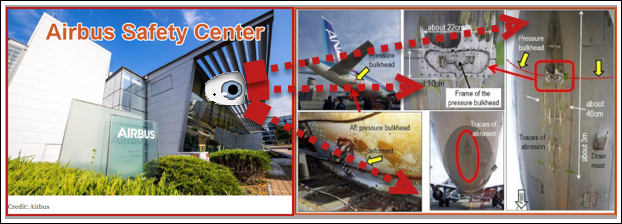AIRBUS’s tailstrike remedial action package shows SMS real in Toulouse???

SAFETY MANAGEMENT SYSTEM’s (SMS) strength lies in the proactive use of data. Information accumulating programs, like FOQA, produce indicia of emerging safety risks, but these numbers arriving in the in boxes of the airlines, OEMs and regulator is not enough to assess the potential problem, propose alternatives and finally design, by consensus, the best remedial measures.
The below article by AVIATION DIRECT explains how AIRBUS used the operational incident reports, available to them via SMS, and then proposed a comprehensive set of actions to reduce tailstrikes. The Airbus Safety Center team collected a number of these events and closely examined what was the chain of actions that resulted in these dangerous moments in landing. Their diagnosis was that many pilots tended to PULL THE CONTROL STICK BACK EXCESSIVELY during the go-around.

The OEM, first, enhanced awareness of these phenomena; explained that pilots should be more attentive to “energy management of these ‘go arounds’” and urged that additional training emphasizing PIC/SIC “precise control and decision-making” be implemented.
The Toulouse, FR based company has articulated policies which have encouraged such proactive, thoughtful approach. Here are the themes articulated in Airbus’ Safety Promotion Centre page:
“At Airbus, we are committed to continuous improvement in flight safety. By learning from past accidents, we have helped to reduce the accident rate through the introduction of new technologies on each new generation of aircraft.
“Investigating accidents is an important part of our commitment to safety, and we take our responsibility seriously in ensuring that our products and services meet the highest safety standards. We believe that the safety of a flight relies on a, “safe aircraft, safely operated, in a safe air transport system.”
…
“COLLABORATION AND INFORMATION-SHARING are key to preventing accidents and to further enhancing safety.
“At Airbus, we encourage all our employees to speak up about any safety or quality issues they encounter, and we expect that every team leader or manager listens and takes action.
“We work with all actors across the air transport system to create a culture of safety that ensures the well-being of everyone who flies. We are committed to reporting and sharing safety data, because we understand that WE CAN’T FIX WHAT WE DON’T KNOW ABOUT.
SAFETY IS THE OPPOSITE OF COMPLACENCY. Safety is the result of all of the extra efforts we make to anticipate the risks or threats, and to prevent them becoming events that can cause harm. We constantly strive to enhance safety together in our quest to reach zero accidents.”
Tim Roach, Head of Safety Promotion at Airbus[1]

Other corporate commitments to SMS were words and the actions not so much. This tailskid action plan seems to prove AIRBUS has bought into this discipline- ACTION > WORDS!!!

Tailstrike danger: Airbus demands more sensitivity on the sidestick

In aviation, emergency landings and aborted landings are critical moments that require a high degree of precision and skill from pilots.
Particularly on Airbus aircraft, especially the A320 series, recent reports show a worrying PATTERN OF TAIL STRIKES during go-around maneuvers, i.e. the last-minute abort of a landing.

This issue is taken SERIOUSLY BY AIRBUS’ FLIGHT SAFETY DEPARTMENT, which strongly advises pilots to keep a steadier hand on the controls in such situations.
What is a tailstrike?
A tailstrike occurs when the tail of an aircraft touches the ground while landing or during a go-around. This can cause significant damage to the aircraft’s structure and, in extreme cases, lead to accidents. According to Airbus, a total of 2022 TAILSTRIKE incidents were reported between JANUARY 2024 AND SEPTEMBER 49. [STET?] These include five incidents during takeoff, 23 during landing and 21 during go-arounds close to the ground.
Causes and Recommendations
AIRBUS’ FLIGHT SAFETY DEPARTMENT has found that in many cases pilots tend to PULL THE CONTROL STICK BACK EXCESSIVELY during the go-around. This leads to an increased nose-up attitude of the aircraft, which increases the risk of a tailstrike. Airbus therefore recommends using a less aggressive control command in critical phases and, if necessary, allowing a second ground contact event. Only after the aircraft has made a stable go-around should the flaps and landing gear be retracted.
An example of the dangers of a tailstrike occurred at Heathrow Airport, where an Airbus A350 suffered a tailstrike while just above the ground during a go-around. The incident was due to insufficient power during the aborted landing, which caused the aircraft to touch down again during the go-around. Such incidents highlight the challenges that can arise when flying in critical situations and underline the need for precise control and decision-making.

The way forward
The Airbus Safety Department is continuously working to improve its pilot training programs and ensure that all crews are aware of the best practices in dealing with go-arounds. Following Airbus’ recommendations could help to significantly increase aviation safety and minimize the risk of tailstrikes.

With the increase in air traffic and the challenges it presents, training and raising awareness of pilots on safety issues remains crucial. Airbus highlights that managing energy during a go-around is of paramount importance to ensure the safety of passengers and crew.
The Airbus initiative to raise awareness of the risks of tailstrikes during aborted landings is an important step to further improve aviation safety. With the right training and improved decision-making at critical moments, many of the risks associated with this challenge can be minimized. The aviation industry must constantly work to improve its safety protocols to maintain passenger confidence in aviation.

Head of Safety Promotion – Commercial Aircraft Aviation
Product Safety Promotion Manage Business Performance Improvement
A350 Integrated Avionics Equipment Supplier
Qantas
QANTAS Engineering Technical 1997 – 2005
University of New England Partnerships, Australia
Southpac AerospaceSouthpac Aerospace
Lead Auditor of Quality & Safety
Workplace Safety Certificate IV
